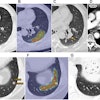A large comparison of two commonly used low-osmolality contrast agents failed to find significant differences in their effect on kidney function, according to a new study in the February issue of the American Journal of Roentgenology.
Although earlier reports had suggested that iopamidol (Isovue 300 mg I/mL, Bracco Diagnostics) might be safer than iohexol (Omnipaque 300 mg I/mL, GE Healthcare) in terms of effects on renal function, the research team said the randomized, double-blind trial found, if anything, only minimal differences that couldn't be considered clinically significant.
"Our investigation shows that in ... outpatients with low-risk for CIN undergoing CT and receiving IV contrast material, there is likely no clinically relevant difference between these two contrast agents with regards to effect on kidney function, wrote lead author Dr. Jonathan Dillman from the University of Michigan in an e-mail to AuntMinnie.com. "While a very tiny difference between contrast agents was identified with respect to change in serum creatinine from baseline, this difference was not statistically significant."
"The radiologic community has commonly assumed that the various nonionic iodinated low-osmolality contrast agents approved for use in the U.S. when administered IV have similar effects on renal function and comparable risks of contrast-induced nephropathy," Dillman and colleagues wrote in their article. "However, there is little direct comparative research to support these presumptions" (AJR, February 2012, Vol. 198:2, pp. 392-397).
Therefore, the study aimed to compare the effects of IV-administered iohexol and iopamidol on serum creatinine (SCr) concentration in outpatients undergoing CT, calculated at baseline and at two and three days after contrast administration. The subjects were prospectively randomized to receive either iohexol or iopamidol, and they were given between 100 mL and 150 mL of the low-osmolality agent. The mean changes in SCr from baseline using the maximum day 2 or day 3 measurement for each subject group were calculated with 95% confidence intervals.
The study population consisted of 389 adults with low risk for contrast-induced nephropathy, who received one agent or the other for a clinically indicated scan. The researchers compared the maximum SCr change between subject groups using a noninferiority analysis with a one-sided significance of 2.5% to convert to a superiority test.
As a secondary end point, contrast-induced nephropathy rates for both contrast agents were compared using three definitions:
- An increase in SCr by ≥ 25% from baseline on either day 2 or day 3 after contrast administration
- An absolute increase in SCr of ≥ 0.5 mg/dL from baseline on either day 2 or day 3 after contrast administration
- An absolute increase in SCr of ≥ 0.3 mg/dL from baseline on either day 2 or day 3 after contrast administration (a diagnostic criterion for acute kidney injury as established by the Acute Kidney Injury Network)
Among the 389 subjects (190 receiving iohexol and 199 receiving iopamidol), 364 were measured at baseline as well as at days 2 and 3. Diabetic status had no statistically significant effect on the primary and secondary end points based on univariate and multivariate analyses, the group reported.
- The mean change in SCr from baseline using the maximum measurement at day 2 or 3 was 0.07 ± 0.12 mg/dL (95% confidence interval [CI]: 0.05 to 0.09 mg/dL) for the iohexol group and 0.05 ± 0.12 mg/dL (95% CI: 0.03 to 0.07 mg/dL) for the iopamidol group.
- The difference between contrast agents regarding the mean maximum change in SCr from baseline was -0.02 ± 0.12 mg/dL (95% CI: -0.045 to 0.003 mg/dL; p = 0.08). Contrast-induced nephropathy rates for the two agents were not statistically different using any definition.
The study was constructed as a noninferiority trial; however, because the 95% confidence interval for the difference between contrast agents for mean change in SCr from baseline was -0.045 to 0.003 mg/dL, "we are unable to show that iohexol is absolutely noninferior to iopamidol," they wrote.
The small difference in SCr "is likely of minimal or no clinical importance in outpatients undergoing CT with low risk for contrast-induced nephropathy," they concluded.
"Additionally, we cannot exclude the possibility that this small difference between contrast agents is due to iohexol causing decreased creatinine secretion at the renal tubular level compared with iopamidol," Dillman and colleagues wrote. "If that is the case, it could be possible that the small difference between contrast agents might not be due to any difference in contrast-mediated nephrotoxicity."
Based on the results of some smaller studies, some researchers have hypothesized that iopamidol might be less harmful to renal function than iohexol. "However, such comparisons have been criticized for a variety of reasons, including their lack of head-to-head nature, different patient populations under investigation (low versus high risk for contrast-induced nephropathy, outpatients versus inpatients, etc.), different routes of contrast material administration (IV versus intra-arterial), and differing definitions of contrast-induced nephropathy," the authors wrote.
Forty-three subjects met the nephropathy criterion of a ≥ 25% increase in SCr from baseline; "however, such a change in renal function could well be due to normal day-to-day variations in SCr in at least some of our subjects," they wrote. In fact, it cannot be known for certain that any change in SCr was due to contrast administration, according to the group.
The present study is the first large trial to compare the two agents prospectively in a similar population, the authors wrote, adding that the results are important because the two agents account for a substantial portion of the low-osmolality contrast agent market in the U.S.
"Our study is unique in that it compares two different low-osmolality iodinated contrast agents in a prospective, randomized, head-to-head manner in nearly-identical patient groups and using similar routes of contrast material administration," Dillman wrote in his e-mail. "Studies with this sort of design are generally lacking in [contrast-induced nephropathy] literature."
The results differ from those of Solomon et al, who, in a meta-analysis of 22 studies involving 3,112 patients, found increased risk of contrast-induced nephropathy in individuals receiving iohexol (19.9%) versus iopamidol (9.0%). However, all of the patients had significant renal dysfunction, and most of the contrast was administered intra-arterially rather than intravenously. Finally, there was "substantial heterogeneity" in the results of the various studies, Dillman and colleagues noted.
"We conclude that, when administered IV, both iohexol and iopamidol are extremely safe in the overwhelming majority of individuals who undergo contrast-enhanced CT," the authors concluded.
| The study was funded by a grant from GE Healthcare. |




















